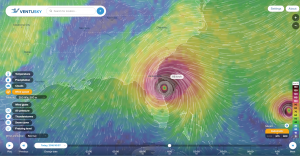Light pollution is a byproduct of most human settlements, especially since the industrial revolution and the harnessing of electricity with the light bulb. Although artificial light has become a nearly unavoidable facet of modern life, light pollution can have adverse environmental effects on both plants and animals, and can also reduce the natural beauty of dark night skies.
This light pollution map [LINK: http://www.lightpollutionmap.info/#zoom=4&lat=5759860&lon=1619364&layers=B0TFFFF] is designed to reveal the extent of light pollution across all of Earth’s continents. The map aggregates Sky Quality measurements from the Earth Observation Group and the NOAA National Geophysical Data Center, and then produces a gradient that overlays a Bing map of the Earth. The gradient reflects anthropogenic radiance in watts per square meter. The user can toggle features of the map layers, including altering which year’s data set is being displayed.
Perhaps the most interesting component of the map is the ability to pinpoint more specific locations and their radiance using the search/pinpoint/drawing functions on the left side of the screen. The ruler feature functions the same way as the ruler featured in Google Earth, allowing the user to measure between two distances. This tool is particularly useful in gauging how far away from a light source the light pollution spreads. For example, measuring the distance from end to end of the patch of radiance surrounding Richmond can help the user make inferences about how intense particular city’s light pollution can be. Also noteworthy is the Radiance Area tool, which allows the user to draw a figure with three or more sides over any area on Earth. The system then produces information about the area given.
Worth noting–and also mentioned in the site’s FAQ–is that Canada appears to be covered in light pollution. This discoloration on the map is somewhat misleading; although Canada does experience light pollution in its major cities, most of the light pollution pictured on the map is actually caused by aurora borealis, which is visible from many parts of northern Canada and disrupts the radiance measurements that are displayed on the map.
Try finding your home town on the map! Looking at my home outside of Los Angeles from high above made it seem like my particular street was contributing to lots of the light pollution, but zooming in, it is actually possible to see the variation from street to street. The street I live on emits nearly 4 times less radiance than one of the larger streets only a few blocks over. It’s very cool!

